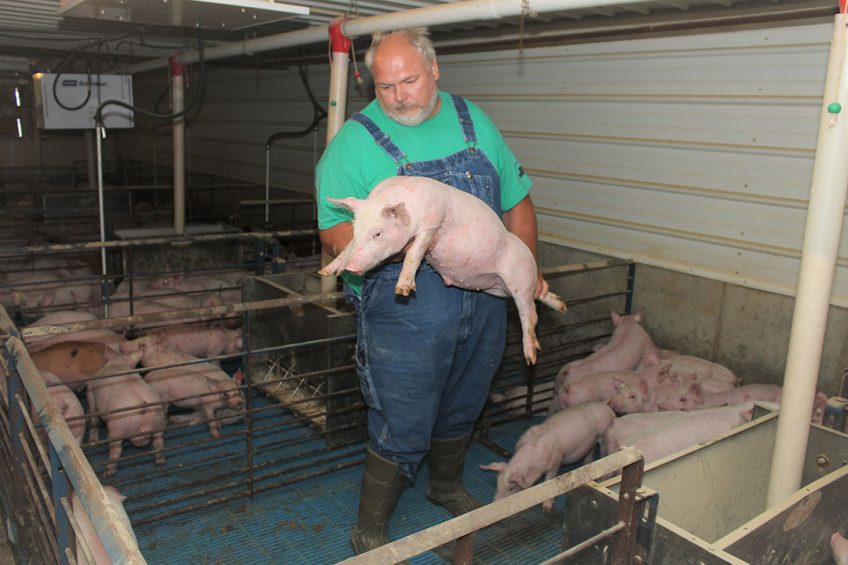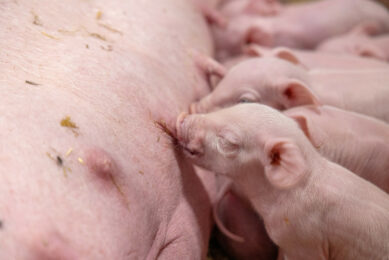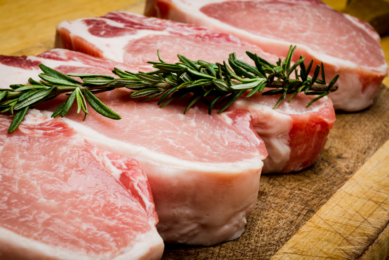A special marriage to a breeding company

In 2017, Schwartz Farms in Missouri, USA, teamed up with genetics company Choice to become part of its breeding research programme. With the company’s genetics, the farm breeds pigs for monitoring purposes – after all, one needs to test to know how the eventual finishers are performing.
Brian Schwartz walks to the end of his grower room, which consists of about six pens plus an aisle. “We divided the pigs in these rooms in two, the boys closer to the door, the girls to the end. That is because the girls urinate backwards – you can see it, it is wet in the aisle there, but it is dry close to the door. That is why we moved all the girls to the pens in the back of the room. I don’t have to walk through it now – keeping my boots and the aisles much cleaner.”
It is a small adjustment, but it is typical for Brian Schwartz and his wife Phyllis, who run a 600-sow farrow-to-wean facility near Stover, MO, United States. The couple appreciate tidiness on-farm, which is reflected in spotless aisles and absence of flies. The two appreciate having a bigger goal than just being a regular producer for the commercial market. Hence they were the right companion for swine breeder Choice, which approached them in 2017 to cooperate within their applied research programme.

“We were looking for some swine farmers whom we could trust, and who are really up for the job that we would like them to do for us,” says James Rohl, geneticist at Choice. “This farm is located in an isolated area, with no other swine farm in a 5 mile (8 km, ed.) radius,” adds Mr Schwartz. “The trees around the property also help to enhance biosecurity.”
“We had been out of swine for a few years,” describes Phyllis Schwartz. The Schwartz’ sow facility was built on a rocky area of their estate in 1998 and has been in use for other breeding companies. In 2013, the Schwartz decided to pull the plug from their pig activities. “But since we had been in the pig business for almost 20 years, we kept our contacts and knowledge up-to-date,” she adds.

Now their daughter Chloe and her husband Sean indicated to be ready to also embark on a future in swine production, the family opted for a come-back. Brian Schwartz says, “And I hate to admit it, but in the four years that we were out of it, I missed the actual pig work.”
Keeping the pigs under commercial conditions
For genetics company Choice, that proved to be a healthy development. The breeding company does have its nucleus units, like e.g. elsewhere in Missouri, but as Mr Rohl explains, there the animals are kept and perform under stringent health conditions. He says, “What we needed were pigs from our lines that would be growing under commercial conditions – and that we could follow and monitor.” In this process, the Schwartz farm facility plays an important role. The farm breeds and delivers weaner pigs of around eight weeks (around 50lbs or 23kg).

“All swine continue to be owned by Choice – and so do the feed, the medicines and the ear tags,” explains Mrs Schwartz. After these eight weeks, the animals are being either shipped to other locations for intensive monitoring research with regard to offspring performance – or they are shipped for finishing elsewhere, e.g. in Iowa or Nebraska. “We will get paid an amount for all pigs we deliver. This way, the agreement gives us a lot of stability.”

Ear tags are an essential part of the function of the Schwartz farm. Together with other processes like e.g. tail docking and the administration of amoxicillin, each piglet born will be given an ear tag with a barcode, which can be read with a tracker. This way the performance of each individual pig can be monitored. All sows also have ear tags – and all of them have colours. The colour of the ear tag reveals the animal’s position in the breeding pyramid. Schwartz Farms has:
• Large White sows (GGP)
• Large White (GP)
• Large White x Landrace sows (PS)
At Schwartz Farms, the sows are being inseminated by Duroc and Piétrain semen, which is obtained from Choice. As the farm is closed, some selected female piglets from GGP mothers will not leave the farm but will be used as breeding animals as well.
The gestation facility
A tour through the facility starts with the breeding and gestating facility, which is located in the left leg of the H-shaped farm. The sows (and a handful of boars for heat detection purposes) are kept in crates, fresh water is provided through little canals on the floors. The sows are fed twice a day, and receive a daily ration of 4.5lbs (2kg). The animals are all kept comfortably cool due to tunnel-ventilation.

The lactation facility
Lactation happens in four tunnel-ventilated rooms each with 24 farrowing crates, in the right leg of the H-shaped farm. Feeding is being done by hand, also to keep a close eye on the development of the sows and their litters. Piglets are only vaccinated against PCV2.
The floors are being equipped with Danish-made Ikadan plastic floors – bright blue. “That helps to see when you are cleaning out the farm site,” says Mr Schwartz. “In case it isn’t blue after cleaning and disinfection, then it isn’t done properly.”
The piglets are kept with their mothers until they are about 19-21 days of age, after which they are moved to the grower rooms. “We are planning to add another room for 24 farrowing crates,” says Mr Schwartz. “That way we boost capacity and we can keep the piglets with their sows a little longer than we can now.” Ideally Mr Schwartz would like to have ‘turnaround crates’ added, i.e. crates which can give sows some liberty after the first few days after farrowing.

The growing facility
Last but not least in this H-shaped facility, there are eight rooms each with 250 grower pigs. In rooms with just-weaned piglets, the temperature is kept relatively high (88ºF or 31ºC), in rooms with older animals – which have already grown to considerable size, the temperatures are lower again. The animals stay here for about four weeks after weaning.
New: the Gilt Developer Unit (GDU)
A new addition to the farm – about 400m away from the main facility – is the Gilt Developer Unit (GDU) – a direct result of the cooperation with Choice. Here, new young female animals will be brought in and will be raised to become gilts for production. In the initial stages, this will be for gilts from the Choice nucleus farm elsewhere in Missouri – at a later stage, this will the place where the young female pigs go after the growing facility.

Experiences
With breeding having started only relatively recently, at the time of the visit, there were no parity-2 sows on-farm. Figures like average daily gain or piglets weaned per sow per year were therefore hard to give. Interim results on the basis of the first gilt rounds look promising though. Gilts there reached an average litter size of 12.4 piglets – which could be extrapolated to an amount of 30 piglets per sow per year.
| PROFILE Name: Brian and Phyllis Schwartz, age 50 and 51. Function: Owners Farm: Schwartz Farm is a diversified farm site with 600 sows, 250 beef cows and their heifers and 600 acres (243ha) of mostly grassland. In addition to this farm, Mr Schwartz’ brother Anthony Schwartz runs another four finisher barns down the road. Schwartz Farms decided to fill up its sow facility after having had empty barns for four years. The couple teamed up with genetics company Choice, to provide young animals for the company to meticulously observe their growth progress. |
Great results, says Mrs Schwartz, beaming at that promise. The couple could notice the benefits of their new breeding lines also in other characteristics – they mention e.g. uniformity as well as the calm and friendly character of the sows – they lie down easier after someone has entered the room. Mr Schwartz can just agree: “I’m just glad we did it.”










